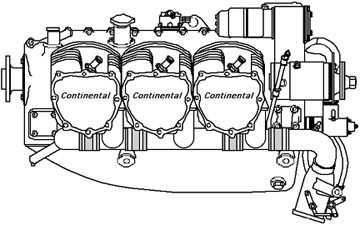Adds Models To Previous AD For Engines With Superior Air Parts, Inc. (SAP) Cylinder Assemblies Installed
The FAA posted a notice in the federal register late last week that it is superseding airworthiness directive (AD) 2009-16-03 for certain Continental Motors, Inc. (CMI) IO-520, TSIO-520, and IO-550 series reciprocating engines, with certain SAP replacement parts manufacturer approval (PMA) investment cast cylinder assemblies installed. The overall cost of complying with the AD is calculated to be north of $14 million.

AD 2009-16-03 required initial and repetitive inspections and compression tests to detect cracks in those cylinders. This new AD requires that additional engines be added to the applicability. The agency says the AD was prompted by the need to add to the applicability all other engine models approved for the use of CMI 520 and 550 cylinder assemblies, such as the CMI 470 series engines when modified by supplemental type certificate (STC), with affected SAP investment cast cylinder assemblies installed.
In comments on the initial AD, Superior Air Parts had requested that the FAA delete the requirement to remove cylinders after 12 years. The FAA said that the 12-year calendar requirement is due to the increased risk of environmental corrosion, a corresponding increase in potential for metal fatigue cracks, and the subsequent separation of the cylinder assemblies. The agency said the type certificate holder recommends removal and replacement of the cylinders no later than 12 years from date placed in service, and did not change the AD.
Additionally, SAP had requested that the FAA delete from the applicability of this AD the Continental Motors, Inc. model CMI 470 series engines that are added to the applicability of this supersedure AD, and that it cancel this supersedure AD. SAP said it is not aware of any problems with the investment cast SAP cylinders installed on CMI model 470 series engines modified by STC to install SAP 520 cylinder assemblies. The FAA countered that it is not aware of data that would indicate that the failure mode of SAP 520 cylinder assemblies identified in this AD would not also exist in the comparatively small population of CMI model 470 series engines modified by STC.

Finally, SAP had requested that paragraph (j) be changed to allow reinstallation of cylinders that have been removed for maintenance because the removal and reinstallation of a cylinder does not impact cylinder head fatigue. The FAA said the purpose of this AD is to correct an unsafe condition by removing from service SAP investment cast cylinder assemblies, and again did not change the AD.
The FAA estimates that this AD affects 6,000 engines installed on airplanes of U.S. registry, and that it will take about 5 hours to replace a cylinder, and 15 hours per engine to inspect the cylinders. The average labor rate is $85 per hour. Required parts will cost about $1,200 per cylinder. The agency anticipates that 4,000 cylinders will require replacement. Based on these figures, the total cost of this AD to U.S. operators is calculated to be $14,150,000.
FMI: AD
 ANN's Daily Aero-Linx (05.02.24)
ANN's Daily Aero-Linx (05.02.24) ANN's Daily Aero-Term (05.02.24): Touchdown Zone Lighting
ANN's Daily Aero-Term (05.02.24): Touchdown Zone Lighting Aero-News: Quote of the Day (05.02.24)
Aero-News: Quote of the Day (05.02.24) ANN FAQ: Contributing To Aero-TV
ANN FAQ: Contributing To Aero-TV NTSB Final Report: Cirrus Design Corp SR20
NTSB Final Report: Cirrus Design Corp SR20




